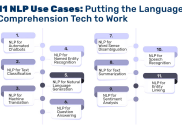
Why Now Is the Time to Embrace AI Implementation
There seems to be a significant gap between the ways organizations talk about AI and the ways they use it within their businesses. Despite 90% of well-known companies investing in AI, it turns out only 35% of businesses actually use it. That means the majority of these companies believe AI is a worthwhile investment but aren’t putting that investment to good use.
It’s a head-scratching statistic that might lead some to believe that AI is more sizzle than steak. In actuality, however, the reasons so few companies haven’t successfully implemented AI stem from practical worries, not from a lack of confidence in the technology itself.
Why Aren’t Companies Using Data for AI Solutions?
There are four main reasons companies fail to use their data to build internal AI solutions:
· They lack the technical expertise necessary for building AI solutions.
· Their data is either of insufficient quality or not in the right format to be used in AI applications.
· The costs associated with developing and deploying proprietary AI seem too high to justify.
· They lack clear objectives and strategies for building successful AI implementation strategies.
Any one of these obstacles can be enough reason for a company to forego AI implementation, even as they invest in the technology. By doing this, however, businesses are essentially giving competitors an edge that they could be taking advantage of themselves.
You Need to Walk the AI Walk
Starting a company that helps develop AI solutions for other businesses, I’ve not only seen the ways data and AI can improve other companies, but I’ve also experienced the ways in which it has helped our own business. We’ve deployed AI to optimize our product development cycles and even built new AI models to help us swiftly solve problems for both our company and clients.
This experience has helped us better understand how businesses use AI and why more organizations should start implementing AI for themselves.
Advantages of Adopting AI
Here are some of the benefits of adopting AI:
· Improved decision-making: Companies can use their data and AI to identify trends, uncover correlations, and detect anomalies. This helps them make better decisions and more easily adapt to market changes and shifts in customer demands.
· Automated processes: AI can automate tedious and repetitive tasks, freeing up employees’ time for more high-value activities.
· Increased efficiencies: AI can analyze companies’ operations and processes and figure out ways to improve upon them. This can result in greater efficiencies, fewer errors, and significant cost savings.
· Enhanced customer experiences: Companies can use AI to deliver personalized experiences to customers, leading to stronger customer relationships and increased loyalty.
· New insights: AI uncovers insights and patterns that would be difficult to discover manually, enabling companies to take advantage of new opportunities and giving them a competitive edge.
If you’re investing in AI but not applying it to your business, these are the advantages you’re leaving on the table.
However, though this might all sound nice in theory, the practicalities of actually incorporating AI into your business can be daunting, particularly if you’re facing some of the challenges mentioned above. With that in mind, then, here are three steps that can act as your AI implementation guide:
1. Start With a Strategy.
Develop a clear AI implementation strategy with your team. This should outline the goals, objectives, and timelines needed for incorporating AI solutions into your business. Creating this plan upfront will help ensure everyone is on the same page — something that’s especially important when dealing with AI implementation.
2. Trust in Data Science.
Use data science to build models and algorithms that can interpret, analyze, and predict data. This will help you gain insights into customer behaviors and trends, which, in turn, can allow you to better understand your business and make more informed decisions.
Keep in mind that while you might already have a data scientist on staff, they aren’t necessarily the right person for dealing with AI-related data.
You need to make sure you have a data scientist focused solely on getting pragmatic results, devoid of company politics and culture. In many cases, it’s best to have this come from a third party.
3. Evaluate, Monitor, and Update.
The world is dynamic, and so is your business. The traditional idea of updating an AI model once a year, quarter, or even once a month is long gone. In fact, any company still doing this would probably be better off disabling their AI models altogether. Machine learning models are like bread: great when freshly baked but bound to become stale over time.
Once you’ve implemented an AI solution, it’s important to evaluate and monitor the system’s performance to ensure it’s running as expected and providing the desired results.
Make sure to review your performance data regularly and make adjustments as needed. Many modern organizations — the ones taking leaps in their industries — will even use AI to monitor and update their existing AI models.
The Bottom Line
Using your own data to build meaningful AI solutions builds up your competitive advantage, improves customer satisfaction, and helps reduce costs while growing revenue. With your data and AI solutions working together, you can make informed decisions that will help you navigate the present and adapt to the future.





